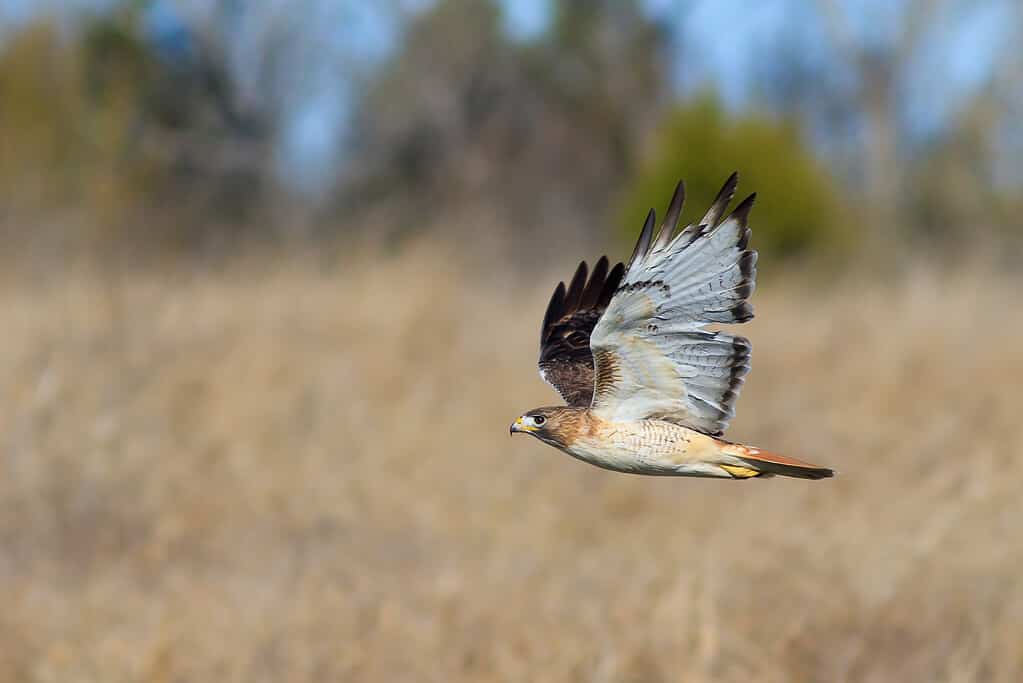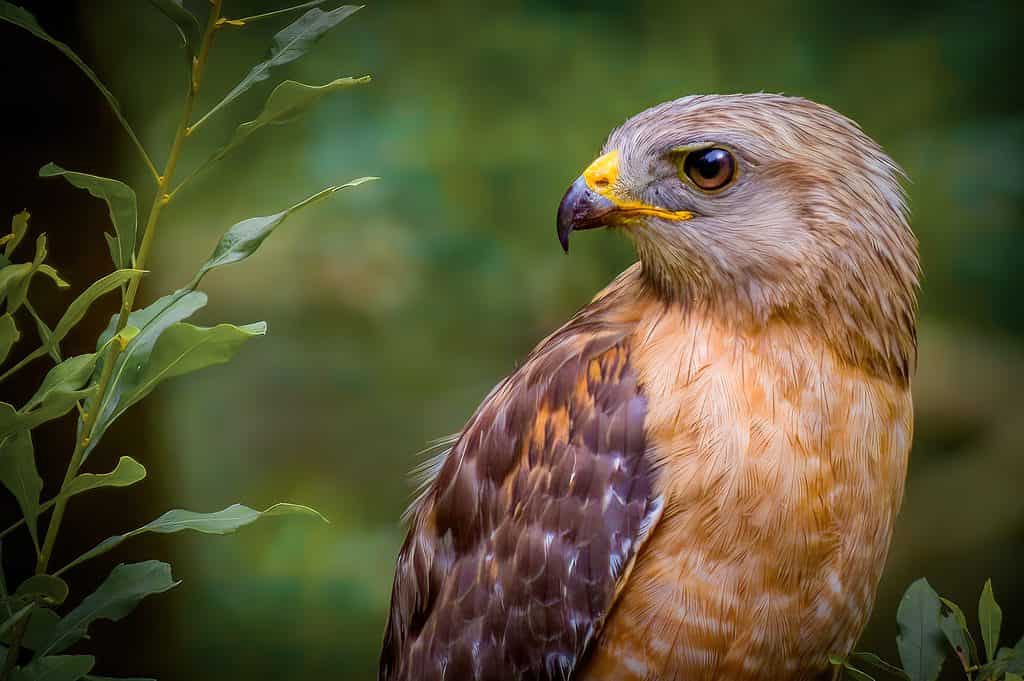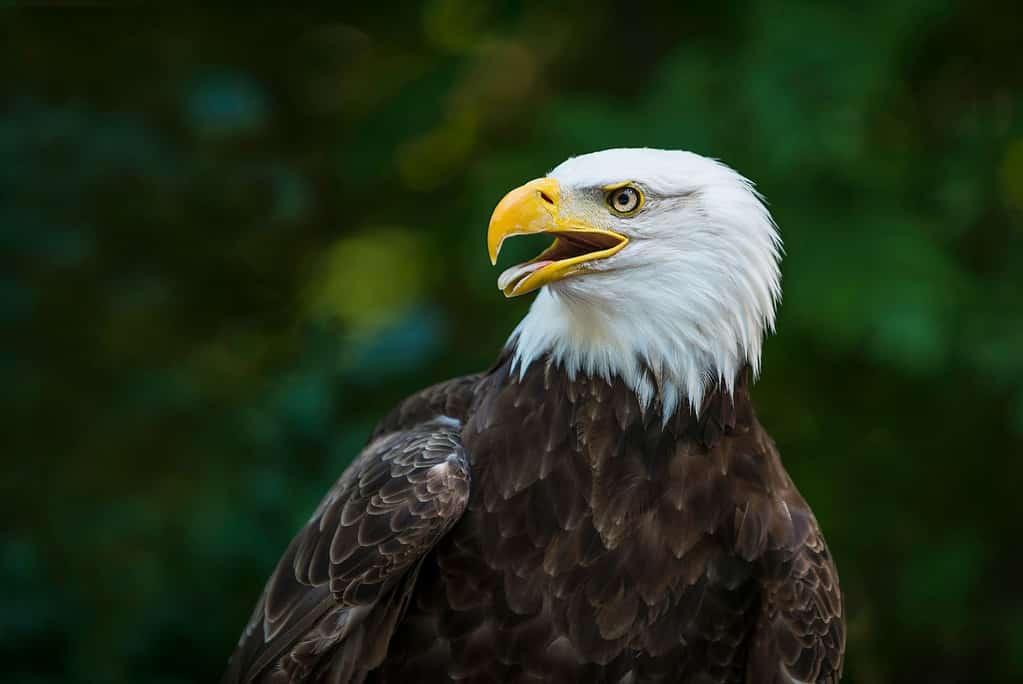In this fascinating article, we explore the incredible visual abilities of hawks and just how far they can see. Hawks are renowned for their keen eyesight, which allows them to spot prey from great distances with remarkable accuracy. But just how far can they actually see? Through extensive research and scientific studies, we delve into the inner workings of hawk vision and reveal some astonishing facts about these majestic birds of prey. So join us as we embark on a journey to discover just how amazingly far hawks can see!
About Hawks

Red-tailed hawk in flight is a beautiful thing to see.
©iStock.com/cmcneill17
Hawks are birds of prey that belong to the family Accipitridae. They come in a variety of species, each with unique physical characteristics and behavior patterns. Generally speaking, hawks have sharp beaks and talons that enable them to hunt and capture their prey effectively. Their wingspan can range from 18 inches to over 4 feet, depending on the species.
In terms of appearance, hawks typically have long tails and broad wings for soaring through the air. Some species also have distinctive markings on their feathers, such as stripes or spots, which aid in camouflaging themselves while hunting.
While there are many different types of hawks, they all share one common trait: exceptional eyesight. Hawks possess incredibly keen vision thanks to a high density of photoreceptors within their eyes, which allows them to detect even small movements from great distances away. This remarkable sense makes them excellent hunters, able to spot prey from far away with incredible accuracy.
Overall, these impressive features make hawks fascinating creatures both visually stunning and biologically advanced making them an important part of our ecosystem deserving admiration and protection alike.
How Far Can Hawks See?

Most species of hawk can see 100 feet away.
©WildlifeWorld/Shutterstock.com
Hawks have incredible visual acuity, allowing them to see incredibly far distances with remarkable clarity. Most hawks can see objects 100 feet away clearly. Their sharp eyesight enables them to spot prey from great heights and hunt efficiently in open spaces. In fact, the distance at which hawks can spot their prey depends on several factors, including the species of hawk and the terrain they are hunting in. For example, red-tailed hawks can see tiny prey animals, like mice, from 100 feet away.
How Wide Can Hawks See?
Hawks are truly remarkable creatures with some of the most impressive hunting skills in the animal kingdom. Their superior eyesight plays a significant role in their ability to survive and thrive in their natural habitat. Hawks have a total field of view that extends up to an incredible 280 degrees, which is significantly wider than what humans can see. This wide range of vision gives them access to panoramic views that enable them to spot prey from great distances away.
One unique feature of hawk eyesight is the binocular overlap, which covers approximately 40 degrees. This means that hawks can simultaneously focus on one object or prey using both eyes, creating a single clear image for optimal precision when attacking or diving after prey.
Moreover, hawks possess excellent depth perception abilities due to differences between each eye’s visual input and angle of view. The difference allows for accurate distance estimation by triangulating objects based on their position relative to other objects visible within the bird’s field of view.
With such keen eyesight combined with sharp claws and beaks, hawks are incredibly efficient predators capable of making precise strikes against even the fastest-moving targets, such as squirrels or rabbits. They are skilled hunters who rely heavily on their exceptional vision capabilities for survival and success in nature.
Hawk Eyesight vs. Human Eyesight

Red-shouldered hawks can fly over 100 miles per hour.
©Casey Ray Photography/Shutterstock.com
Some hawks can see up to eight times farther than humans due to their ability to detect UV light, which we cannot see. This means that hawks can not only perceive more colors than humans but also pick up details invisible to us.
Furthermore, some studies suggest that certain species of hawks may be able to differentiate between different colors as well. For example, red-tailed hawks have been observed responding differently when a target object is painted either red or gray.
Overall, it’s clear that these birds of prey possess extraordinary vision capabilities that allow them to navigate their environment with ease and precision.
Hawk Eyesight vs. Eagle Eyesight

Eagles also have great vision. Most raptors do.
Members of the order Accipitriformes (including hawks, eagles, and Old World vultures) tend to have excellent vision, similar to other birds of prey like peregrine falcons, great-horned owls, and American kestrels. However, bald eagles have better long-distance vision than hawks, giving them an edge when searching for prey from the sky.
Bald eagles may not be able to see colors as well as hawks, especially the red-shouldered hawk, rough-legged hawk, and sharp-shinned hawk. This is likely because these hawks hunt more often during the day, and their eyes have adapted to become more sensitive to light. Although both bald eagles and red-tailed hawks have excellent vision, they have different advantages when it comes to their sense of sight.
They Have Great Hearing Too!
Hawks are truly amazing creatures, possessing a range of impressive skills that make them formidable predators in the animal kingdom. While their sharp eyesight is often credited as their most notable attribute, it is important to note that they also have exceptional hearing abilities.
This keen sense of hearing serves hawks well when it comes to hunting. By being able to detect sounds that are beyond human auditory range, these birds can pick up on even the faintest noises made by potential prey. This allows them to locate animals like young birds nestled in trees or small rodents rustling through foliage long before we would even be aware of their presence.
One key advantage for hawks with acute hearing is their ability to track down hidden prey. They can use sound cues and triangulate from different positions using both ears simultaneously – much like how humans perceive where a sound comes from – giving them an accurate idea of where exactly the target is located.
The combination of excellent vision and acute hearing makes hawks one of nature’s most successful hunters. Their predatory prowess has earned them a reputation as skilled birds of prey who reign supreme over other avian species.
In conclusion, while hawks may not get all the credit for having superb hearing abilities compared to their famous visual acuity, this skill plays an essential role in helping these incredible raptors hunt effectively and efficiently.
A Hawk’s Sense of Smell

Scientists have discovered that hawks have a sense of smell.
©iStock.com/neil bowman
In the world of birds, the sense of smell is often overlooked as a key sensory tool. While it’s true that most birds have no sense of smell, recent research has shown that some species may possess olfactory abilities. Among these are hawks, which scientists believe may be able to detect scents in their environment.
Although we don’t yet know exactly how strong a hawk’s sense of smell is, studies have suggested that they can distinguish between different odors and use this information to locate prey or navigate through their territory. Some scientists also speculate that hawks may be able to recognize individual animals by their scent – an ability previously thought to be unique to mammals.
Interestingly, researchers have found that certain species of birds can communicate with each other using smells. For example, seabirds like petrels and shearwaters use chemical cues to find their way back to their nests after foraging at sea. This suggests that scent-based communication could play a role in the social lives of many bird species beyond what was previously thought. Turkey vultures are also known for a keen sense of smell and can locate carrion by following the scent trail in the air.
While much remains unknown about how exactly hawks and other birds use their sense of smell, one thing is clear: these fascinating creatures continue to surprise us with new discoveries about their incredible abilities every day.
Thank you for reading! Have some feedback for us? Contact the AZ Animals editorial team.








